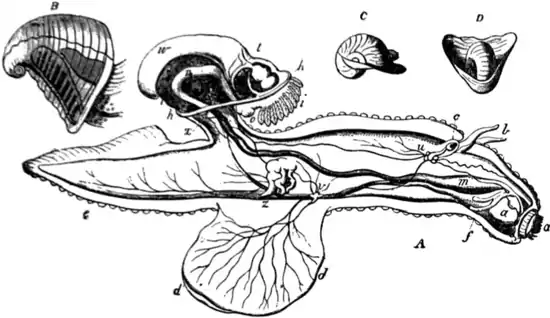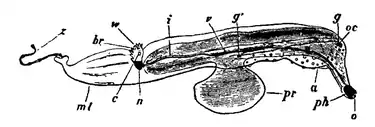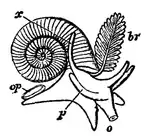STREPTONEURA]
GASTROPODA
515
visceral nerve-loop, the strands of which cross one another—this being characteristic of Streptoneura (Spengel).
 | |||||||
| Fig. 28.—Carinaria mediterranea. (From Owen.) | |||||||
| A, The animal. B, The shell removed. C, D, Two views of the shell of Cardiopoda. | |||||||
| a, | Mouth and odontophore. | h, | Border of the mantle-flap. | u, | Cerebral ganglion. | ||
| b, | Cephalic tentacles. | i, | Ctenidium (gill-plume). | v, | Pleural and pedal ganglion. | ||
| c, | Eye. | m, | Stomach. | w, | Testis. | ||
| d, | The fin-like mesopodium. | n, | Intestine. | x, | Visceral ganglion. | ||
| d’, | Its sucker. | o, | Anus. | y, | Vesicula seminalis. | ||
| e, | Metapodium. | p, | Liver. | z, | Penis. | ||
| f, | Salivary glands. | t, | Aorta, springing from the ventricle. | ||||
The Heteropoda belong to the “pelagic fauna” occurring near the surface in the Mediterranean and great oceans in company with the Pteropoda, the Siphonophorous Hydrozoa, Salpae, Leptocephali, and other specially-modified transparent swimming representatives of various groups of the animal kingdom. In development they pass through the typical trochosphere and veliger stages provided with boat-like shell.
Sub-order 1.—Taenioglossa. Radula with a median tooth and three teeth on each side of it. Formula 3 : 1 : 3.
Tribe 1.—Platypoda. Normal Taenioglossa of creeping habit. The foot is flattened ventrally, at all events in its anterior part (Strombidae). Otocysts situated close to the pedal nerve-centres. Accessory organs are rarely found on the genital ducts, but occur in Paludina, Cyclostoma, Naticidae, Calyptraeidae, &c. Mandibles usually present. This is the largest group of Mollusca, including nearly sixty families, some of which are insufficiently known from the anatomical point of view.
- Fam. 1.—Paludinidae. Pedal centres in the form of ganglionated cords; kidney provided with a ureter; viviparous; fluviatile. Paludina. Neothauma, from Lake Tanganyika. Tylopoma, extinct, Tertiary.
 | |
| Fig. 29.—Pterotrachea mutica seen from the right side. | |
| (After Keferstein.) | |
| a, | Pouch for reception of the snout when retracted. |
| c, | Pericardium. |
| ph, | Pharynx. |
| oc, | Cephalic eye. |
| g, | Cerebral ganglion. |
| g’, | Pleuro-pedal ganglion. |
| pr, | Foot (mesopodium). |
| v, | Stomach. |
| i, | Intestine. |
| n, | So-called nucleus. |
| br, | Branchial plume (ctenidium). |
| w, | Osphradium. |
| mt, | Foot (metapodium). |
| z, | Caudal appendage. |
- Fam. 2.—Cyclophoridae. No ctenidium, pallial cavity transformed into a lung; aperture of shell circular; terrestrial. Pomatias, shell turriculated. Diplommatina. Hybocystis. Cyclophorus, shell umbilicated, with a short spire and horny operculum. Cyclosurus, shell uncoiled. Dermatocera, foot with a horn-shaped protuberance at its posterior end. Spiraculum.
- Fam. 3.—Ampullariidae. To the left of the ctenidium a pulmonary sac, separated from it by an incomplete septum, amphibious. Ampullaria, shell dextral, coiled. Lanistes, shell sinistral, spire short or obsolete. Meladomus.
- Fam. 4.—Littorinidae. Oesophageal pouches present; pedal nerve-centres concentrated; a pedal penis near the right tentacle. Littorina, shell not umbilicated, littoral habit. Lacuna, foot with two posterior appendages, marine, entirely aquatic. Cremnoconchus, entirely aerial, Indian. Risella. Tectarius.
- Fam. 5.—Fossaridae. Head with two lobes in some Rhipidoglossa. Fossaria.
- Fam. 6.—Purpurinidae, extinct.
- Fam. 7.—Planaxidae. Shell with pointed spire; a short pallial siphon. Planaxis.
- Fam. 8.—Cyclostomatidae. Pallial cavity transformed into a lung; pedal centres concentrated; a deep pedal groove. Cyclostoma, shell turbinated, operculum calcareous, British. Omphalotropis.
- Fam. 9.—Aciculidae. Pallial cavity transformed into a lung; operculum horny; shell narrow and elongated. Acicula.
- Fam. 10.—Valvatidae. Ctenidium bipectinate, free; hermaphrodite; fluviatile. Valvata, British.
- Fam. 11.—Rissoidae. Epipodial filaments present; one or two pallial tentacles. Rissoa. Rissoina. Stiva.
- Fam. 12.—Litiopidae. An epipodium bearing three pairs of tentacles and an operculigerous lobe with two appendages; inhabitants of the Sargasso weed. Litiopa.
- Fam. 13.—Adeorbiidae. Mantle with two posterior appendages; ctenidium large and capable of protrusion from pallial cavity. Adeorbis, British.
- Fam. 14.—Jeffreysiidae. Head with two long labial palps; shell ovoid; operculum horny, semicircular, carinated. Jeffreysia.
- Fam. 15.—Homalogyridae. Shell flattened; no cephalic tentacles. Homalogyra, British. Ammoniceras.
- Fam. 16.—Skeneidae. Shell depressed, with rounded aperture; cephalic tentacles long. Skenea, British.
- Fam. 17.—Choristidae. Shell spiral; four cephalic tentacles; eyes absent; two pedal appendages. Choristes.
- Fam. 18.—Assimineidae. Eyes at free extremities of tentacles. Assiminea, estuarine, British.
- Fam. 19.—Truncatellidae. Snout very long, bilobed; foot short. Truncatella.
 | |
|
Fig. 30.—Valvata cristata, Müll. | |
| o, | Mouth. |
| op, | Operculum. |
| br, | Ctenidium (branchial plume). |
| x, | Filiform appendage (? rudimentary ctenidium). |
|
The freely projecting ctenidium of typical form not having its axis fused to the roof of the branchial chamber is the notable character of this genus. | |
- Fam. 20.—Hydrobiidae. Shell with prominent spire; penis distant from right tentacle, generally appendiculated; brackish water or fluviatile. Hydrobia, British. Baikalia, from Lake Baikal. Pomatiopsis. Bithynella. Lithoglyphus. Spekia, viviparous, from Lake Tanganyika. Tanganyicia. Limnotrochus, from Lake Tanganyika. Chytra. Littorinida. Bithynia, British, fluviatile. Stenothyra.
- Fam. 21.—Melaniidae. Spire of shell somewhat elongated; mantle-border fringed; viviparous; fluviatile. Melania. Faunus. Paludomus. Melanopsis. Nassopsis. Bythoceras, from Lake Tanganyika.
- Fam. 22.—Typhobiidae. Foot wide; shell turriculated, with carinated whorls, the carinae tuberculated or spiny. Typhobia. Bathanalia, from Lake Tanganyika.
- Fam. 23.—Pleuroceridae. Like Melaniidae, but mantle-border not fringed and reproduction oviparous. Pleurocera. Anculotus.
- Fam. 24.—Pseudomelaniidae. All extinct.
- Fam. 25.—Subulitidae. All extinct.
- Fam. 26.—Nerineidae. All extinct.
- Fam. 27.—Cerithiidae. Shell with numerous tuberculated whorls; aperture canaliculated anteriorly; short pallial siphon. Cerithium. Bittium. Potamides. Triforis. Laeocochlis. Cerithiopsis.
- Fam. 28.—Modulidae. Shell with short spire; no siphon. Modulus.